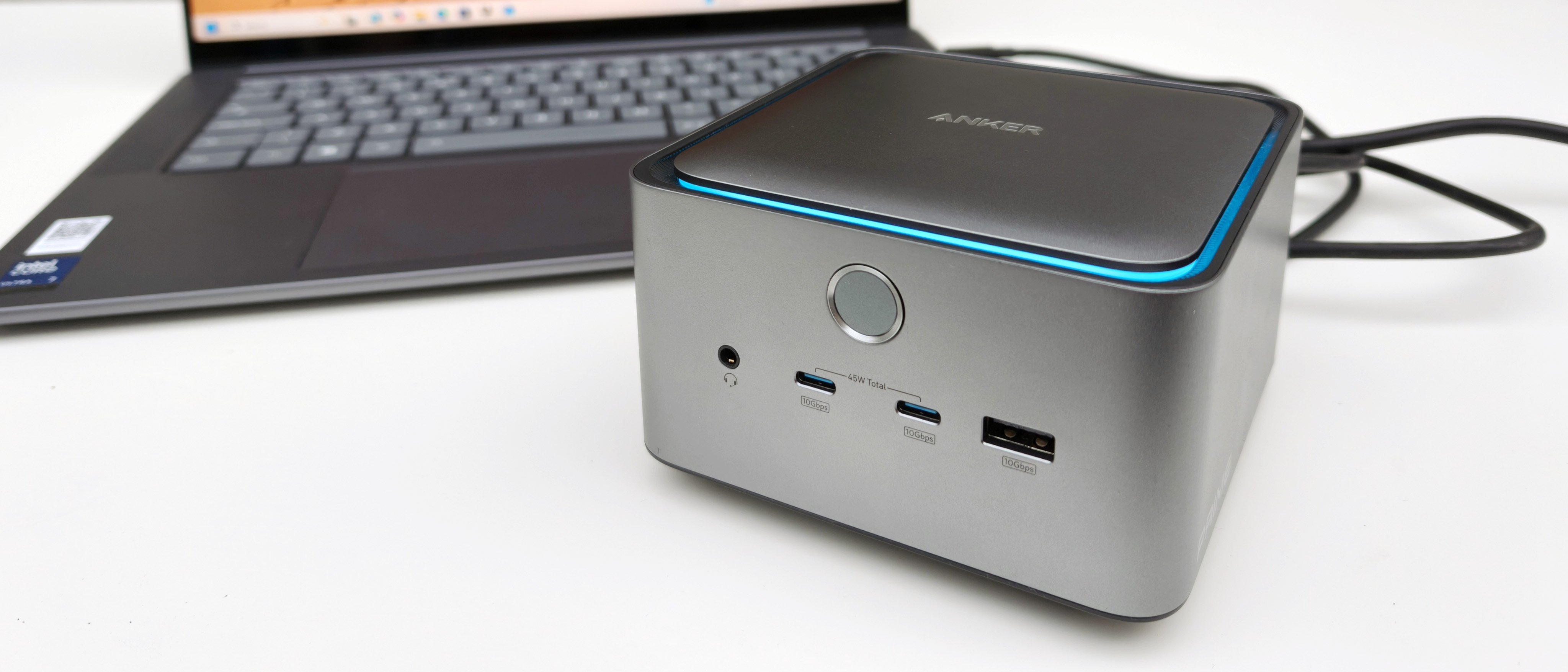Digital Camera World Verdict
The Anker Prime TB5 Docking Station doesn't just add extra ports to your laptop; thanks to its cutting-edge Thunderbolt 5 interface, it manages to do so without negatively impacting data transfer speeds, while simultaneously allowing you to connect dual 8K monitors. This is truly a no-compromise dock, but consequently it comes at a hefty cost. For most users a Thunderbolt 4 docking station will still offer more than enough speed, but for less than half the price.
Pros
- +
Incredibly fast
- +
Excellent build quality
- +
Decent port selection
Cons
- -
Very expensive
- -
Thunderbolt 5 unnecessary for most
Why you can trust Digital Camera World
The best photo-editing laptops are getting thinner and lighter, while simultaneously offering more speed and better battery life. But there's one way in which new laptops are measurably worse than laptops of old: physical connectivity. As laptop manufacturers strive for ever-thinner designs, they also pare down the number of USB ports, and these days you'll also be lucky to find an Ethernet port or SD card reader on the side of a modern thin and light laptop. A worst-case scenario is a device with just two high-speed USB-C ports, where one has to do double duty as the charge socket, leaving you with just a single USB connection for physical data transfer while you're charging.
Thankfully there's no shortage of docking stations that can give you back those lost ports. One convenient dock can provide multiple USB-C and USB-A ports, along with an Ethernet port for wired networking, an SD slot, headphone port and various video connections.
Read more: the best laptop docking stations
Specifications
Ports (front/side) | 2x USB-C (10Gbps), 1x USB-A (10GBps), 3.5mm audio, SD + microSD readers |
Ports (rear) | 2x Thunderbolt 5, 2x USB-A (10Gbps), Ethernet (2.5Gbps), 1x HDMI 2.1, 1x DP 2.1, 1x Thunderbolt 5 (upstream) |
Max monitor support | Dual 8K (windows), Dual 6K (Mac) |
Max charging | 140W to laptop, 45W total to peripherals |
Dimensions | 4.6 × 4.6 × 3.0 in / 116 × 116 × 75 mm |
Features
The Anker Prime TB5 Multi-Function Docking Station represents the pinnacle of what's possible from a laptop docking station, thanks to its cutting-edge Thunderbolt 5 connectivity. As a dock relies on just a single cable to connect it to your laptop, this has the potential to be a significant speed bottleneck for the multiple devices attached to the dock which have to share that one wire.
By utilising Thunderbolt 5 - currently the fastest physical connection for consumer computers - the Anker Prime dock is capable of up to 120Gbps data transfer rates. That's 3x faster than the already-rapid Thunderbolt 4 or USB4 standards. This means you can connect multiple high resolution monitors AND transfer data from high-speed external SSDs or CFexpress cards, simultaneously, and with no perceptible drop in performance.
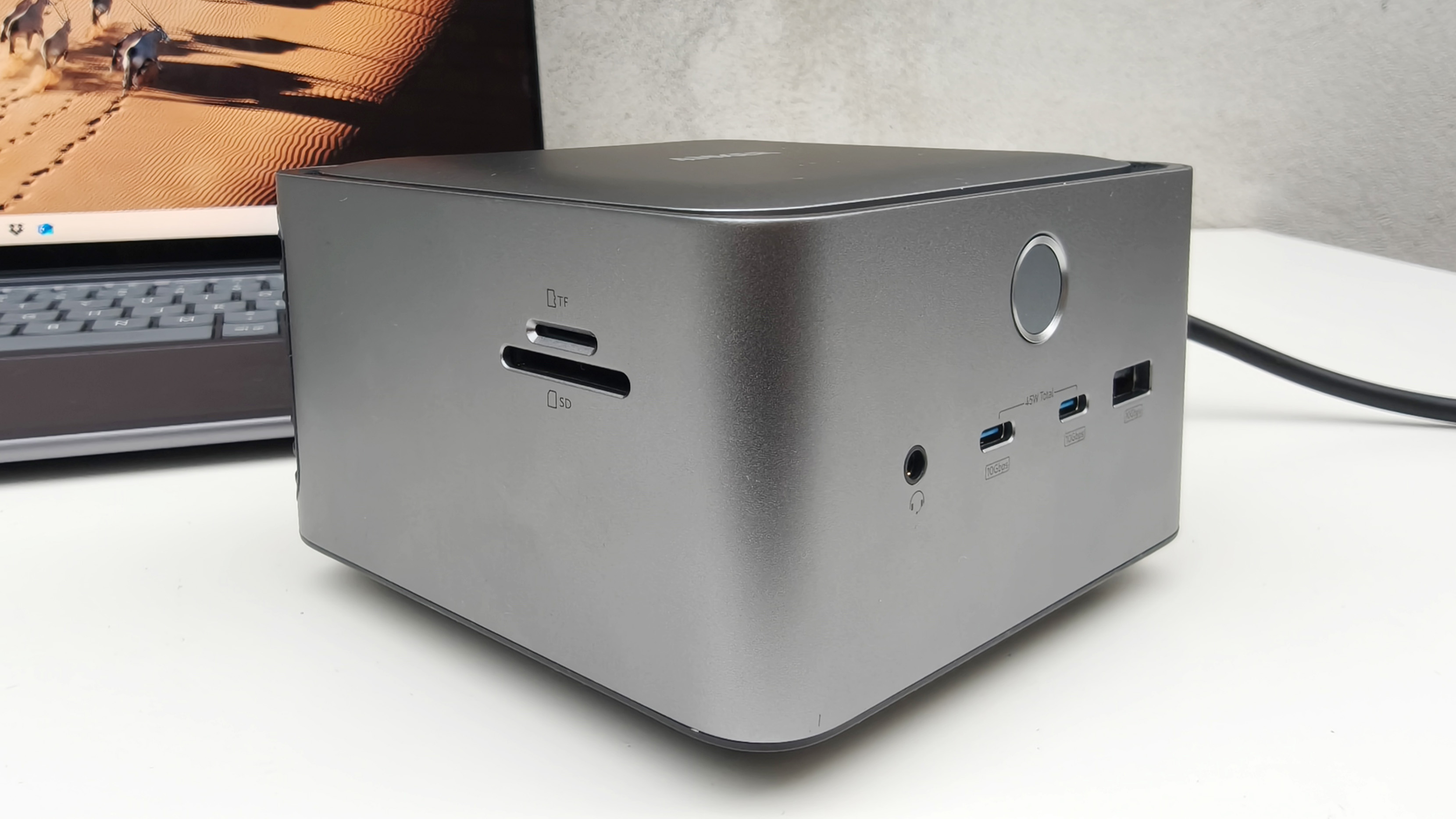
In addition to increasing data transfer speeds, Thunderbolt 5 also allows you to connect higher-quality monitors to your laptop. Where Thunderbolt 4 limited you to two 4K monitors; with Thunderbolt 5 it's possible to use the Anker dock to connect dual 8K monitors to your laptop, each running at 60Hz (Providing you're using a Thunderbolt 5 Windows laptop. Mac OS limits you to dual 6K screens).
Not only does the Anker Prime dock add extra ports to your laptop, it can also power it, being capable of supplying up to 140W of fast charging. This means you can effectively ditch your laptop's own charger and remove clutter from your desk.
The best camera deals, reviews, product advice, and unmissable photography news, direct to your inbox!
Thunderbolt 5 laptops are still relatively rare, having only hit the market in 2024. Thankfully the Anker Prime dock is also compatible with more commonly-available Thunderbolt 4 computers, which includes M1, M2 and M3 MacBooks, though naturally you'll be restricted to Thunderbolt 4's inherent speed, display and power-passthrough limitations. The Anker Prime dock will not work with Thunderbolt 3 or older Thunderbolt versions.
Build & handling
Where many docks are long, rectangular strips, the Anker Prime dock is more of a cube. You could easily be forgiven for thinking it's a mini PC, as its dimensions are similar, while the power button and front-facing ports further accentuate the mini PC look.
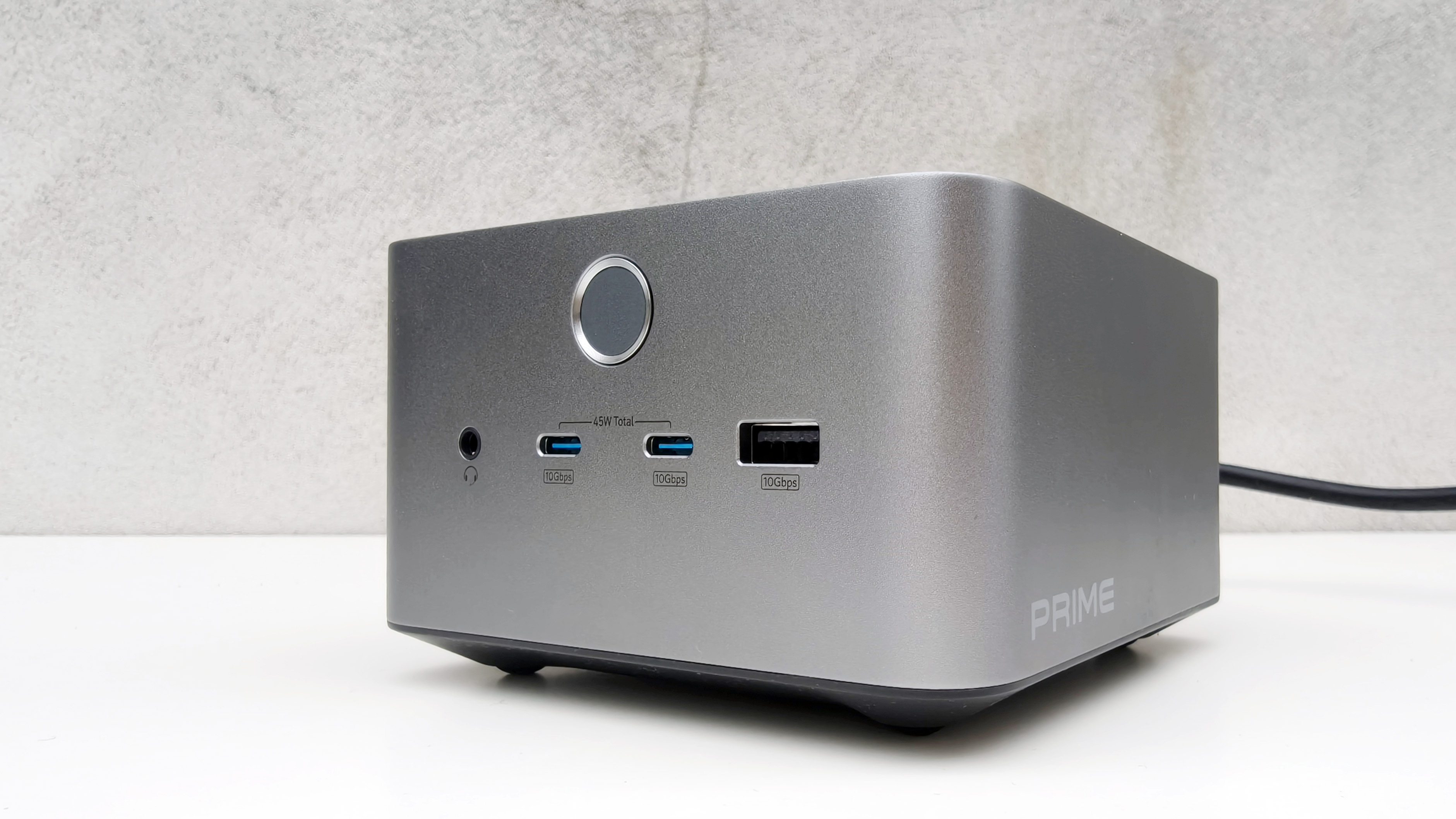
The dock is also surprisingly heavy - way heavier than you'd expect from a box that appears only to feature a selection of sockets and should therefore be mostly hollow. But that's not the case here, as this dock also contains its own power circuitry, which would otherwise be housed in a separate bulky A/C power brick. That means the Anker dock is a neater, one-box package, only requiring a basic power cable to link it to a wall outlet.
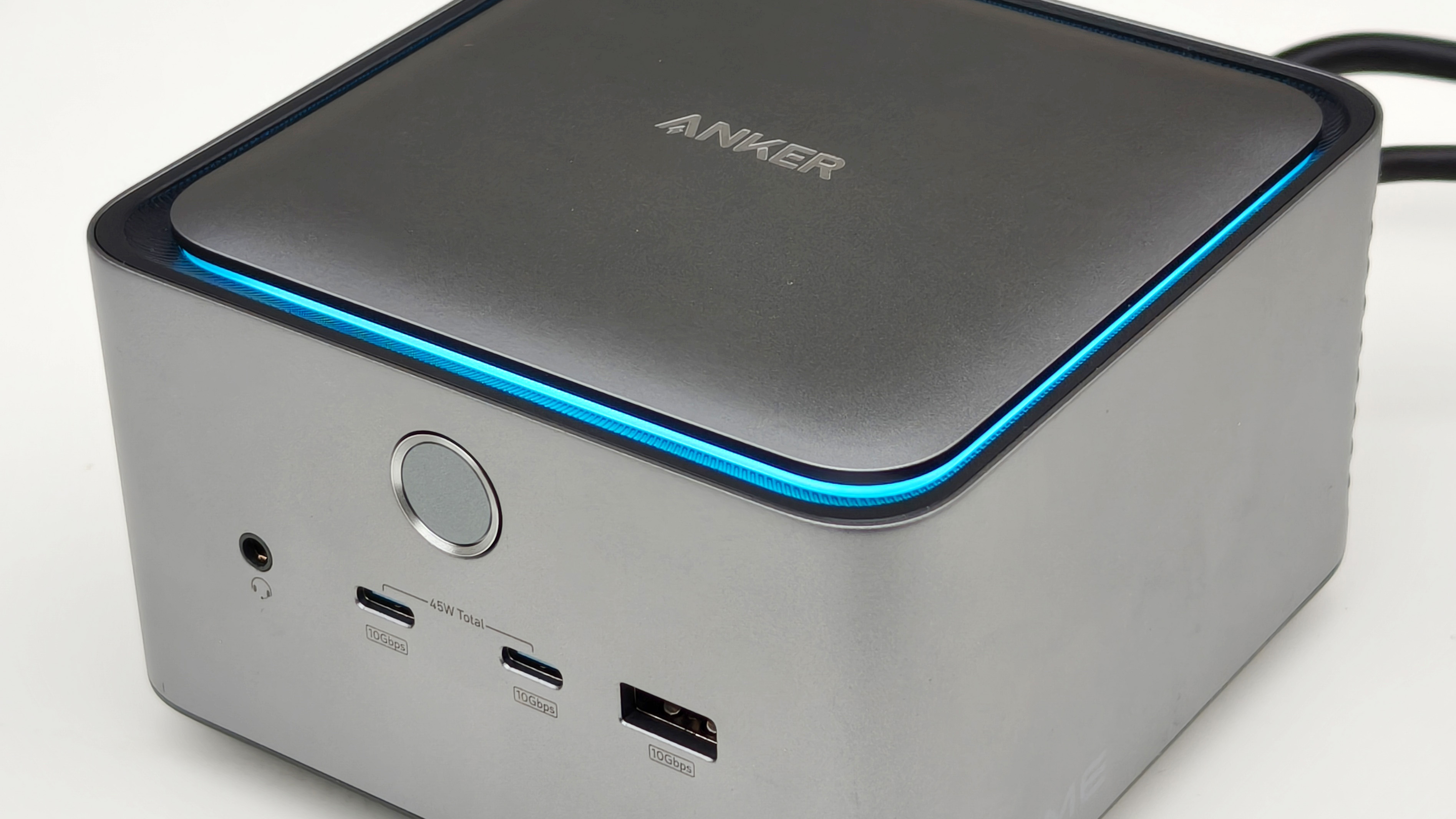
That extra weight also helps the dock sit securely on a desk and provides some helpful resistance when plugging in and removing devices. Build quality is first class, with the matte grey finish complementing many modern laptops. An extra touch of class is the blue status light that glows out from the recess running around the perimeter of the top panel, causing this to seemingly 'float' separately from the rest of the casing.
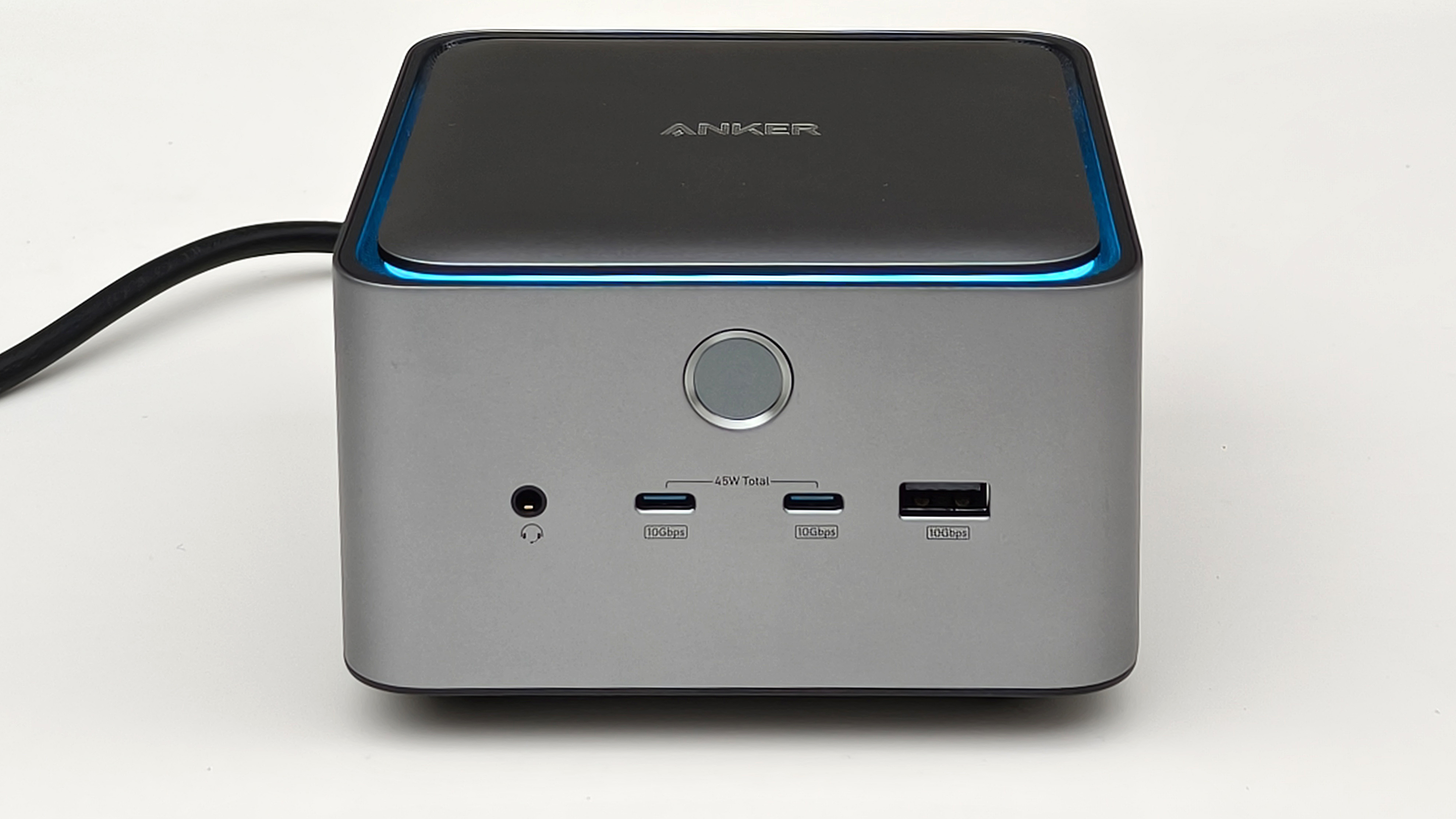
Ports are split between the front and rear panels. The front sports dual 10Gbps USB-C ports, with a combined 45W of Power Delivery, should you wish to plug in your phone or other device to charge. A 10Gbps USB-A port and 3.5mm audio socket round out the front-panel connectivity.
Round back you get two more USB-A connections (also 10Gbps), plus two Type-C ports, this time offering Thunderbolt 5 transfer speeds. For video connections there's an HDMI 2.1 port and a DisplayPort 2.1 socket, though these can not be used simultaneously. A 2.5Gbps Ethernet port is also present, though some may be disappointed that this doesn't run at 10Gbps. Lastly is the single Thunderbolt 5 upstream port that's used to connect the dock to your computer.
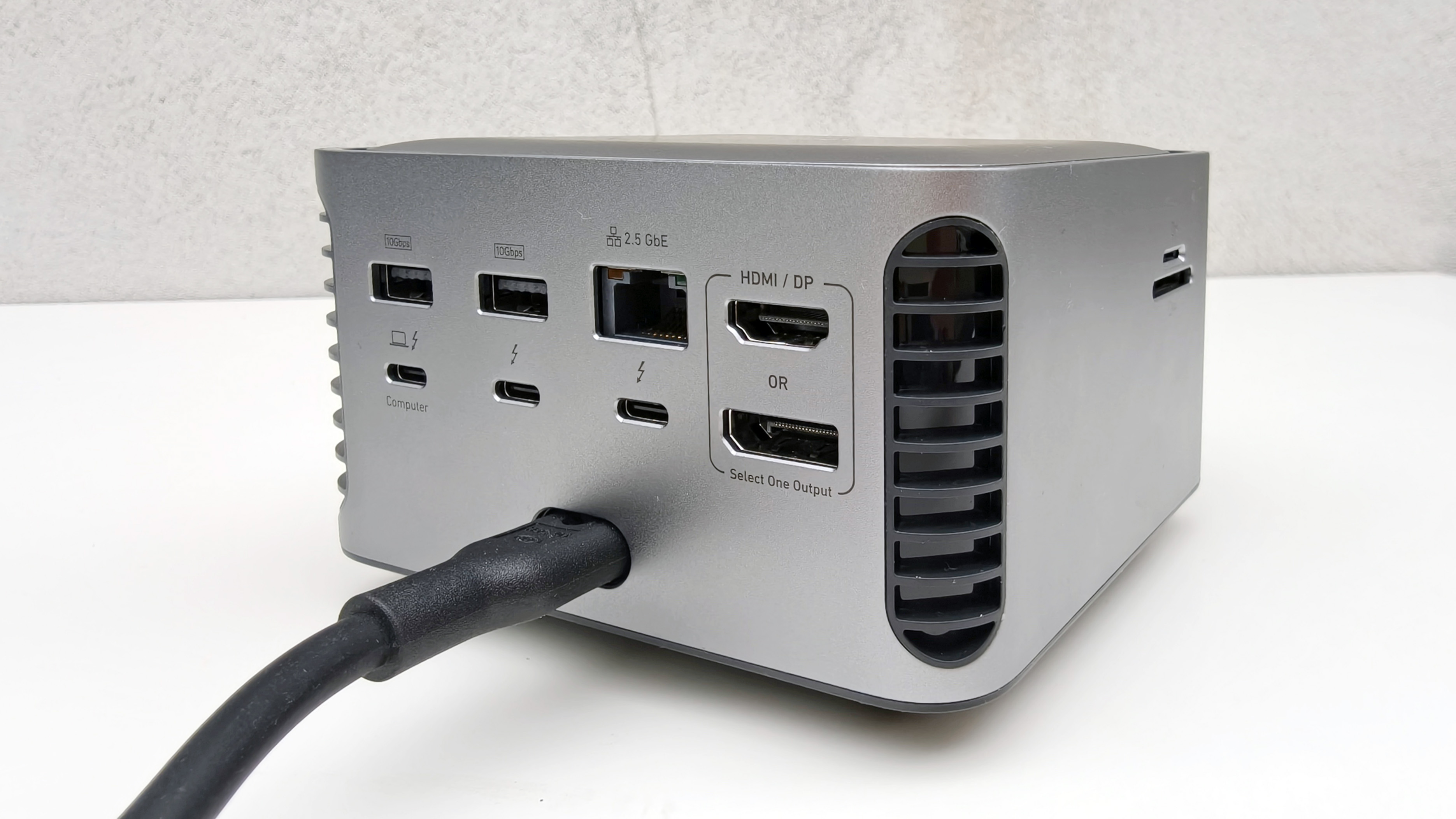
Performance
There isn't a lot to test with a docking station - the ports either work, or they don't. Thankfully I can report that the Anker dock performed almost faultlessly during my testing. As Thunderbolt 5 laptops are still relatively rare, I had no choice but to use the dock in conjunction with a Thunderbolt 4 machine: the Lenovo Yoga Slim 7 15 Aura. This immediately started charging when I connected the dock's included USB-C cable to one of the laptop's two Thunderbolt 4 ports. I then connected a 31.5-inch, 4K monitor to the dock's HDMI socket and the laptop automatically recognised it and duplicated its display onto this second screen.
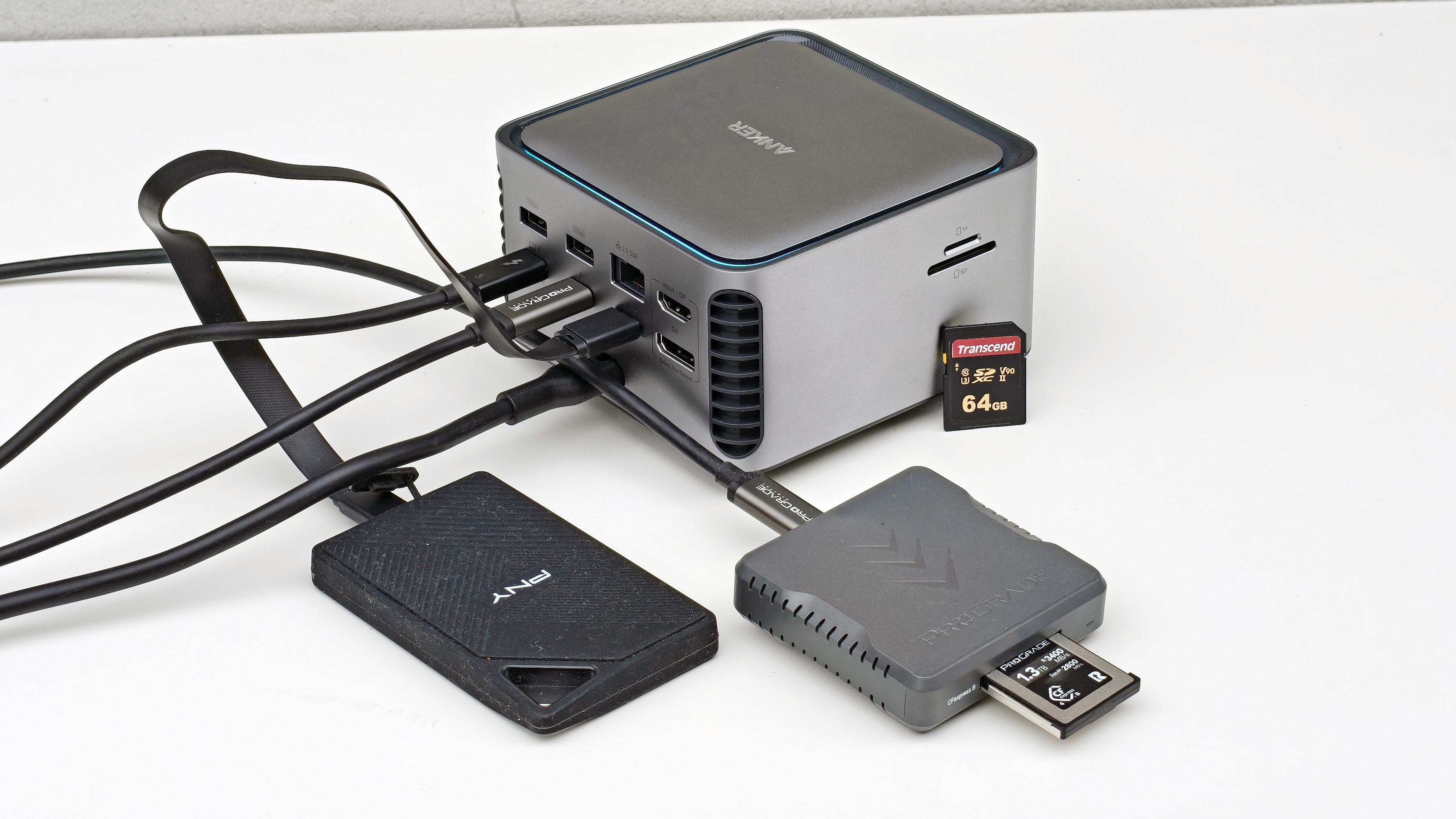
I also wanted to test the speed of the dock's Thunderbolt ports, to see if plugging a fast external SSD into the dock would result in any loss of transfer speed compared to connecting it directly to the laptop.
Thunderbolt speed (portable SSD)

For this test I used a PNY RP60 portable SSD. This runs at USB 3.2 Gen 2x2 speed, and should be capable of a rapid 2000MB/s maximum read speed. As you can see from the speed comparison above, the SSD was almost as fast when connected through the dock as when plugged directly into the test laptop.
Thunderbolt speed (CFexpress 4.0 card)
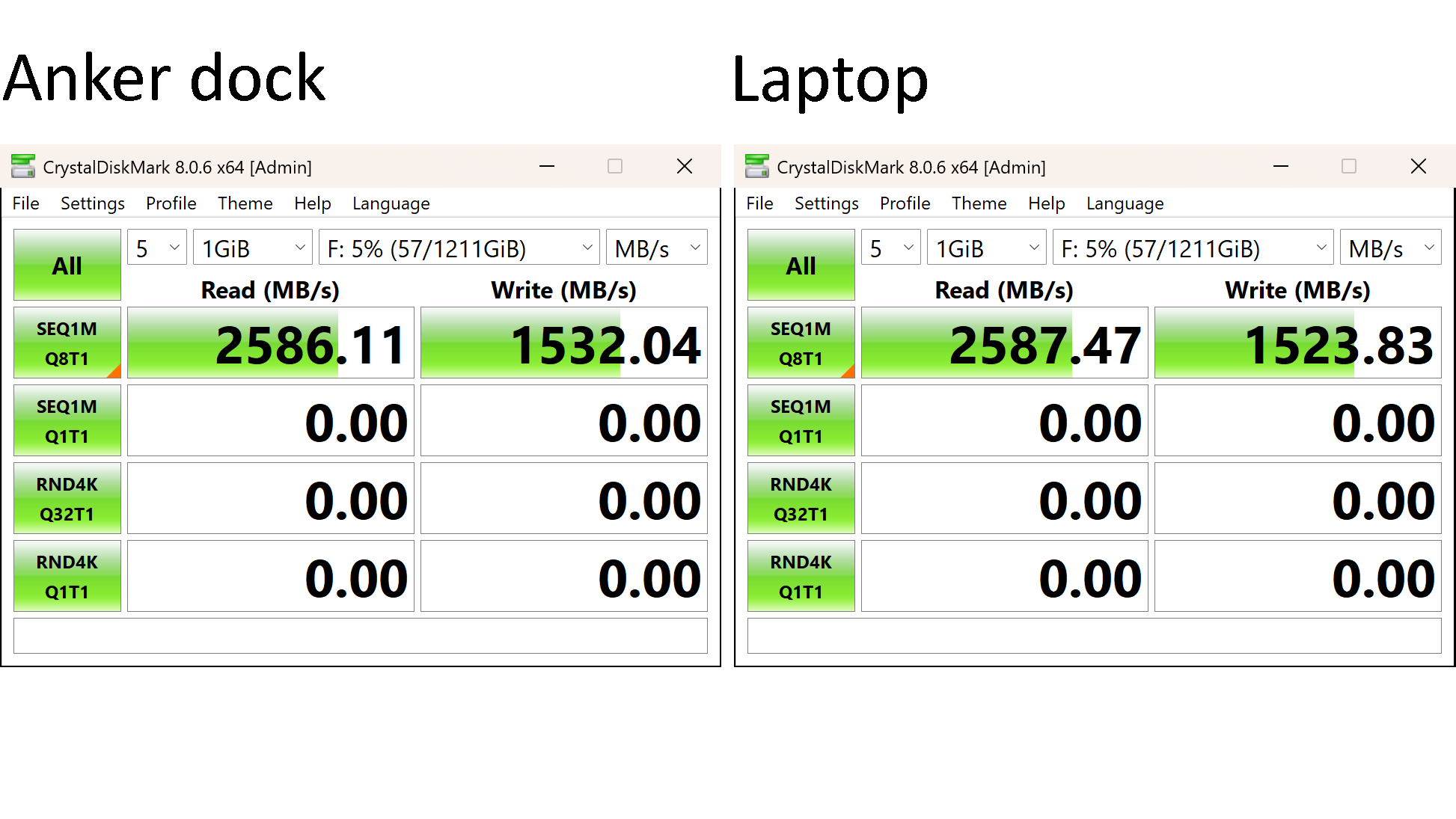
To go even faster than this, I got a ProGrade Digital CFexpress 4.0 Type B card, inserted it into a USB4 Type B card reader and plugged that into the dock. In this test the CFexpress card's write speed was marginally faster when connected through the dock.
SD card reader
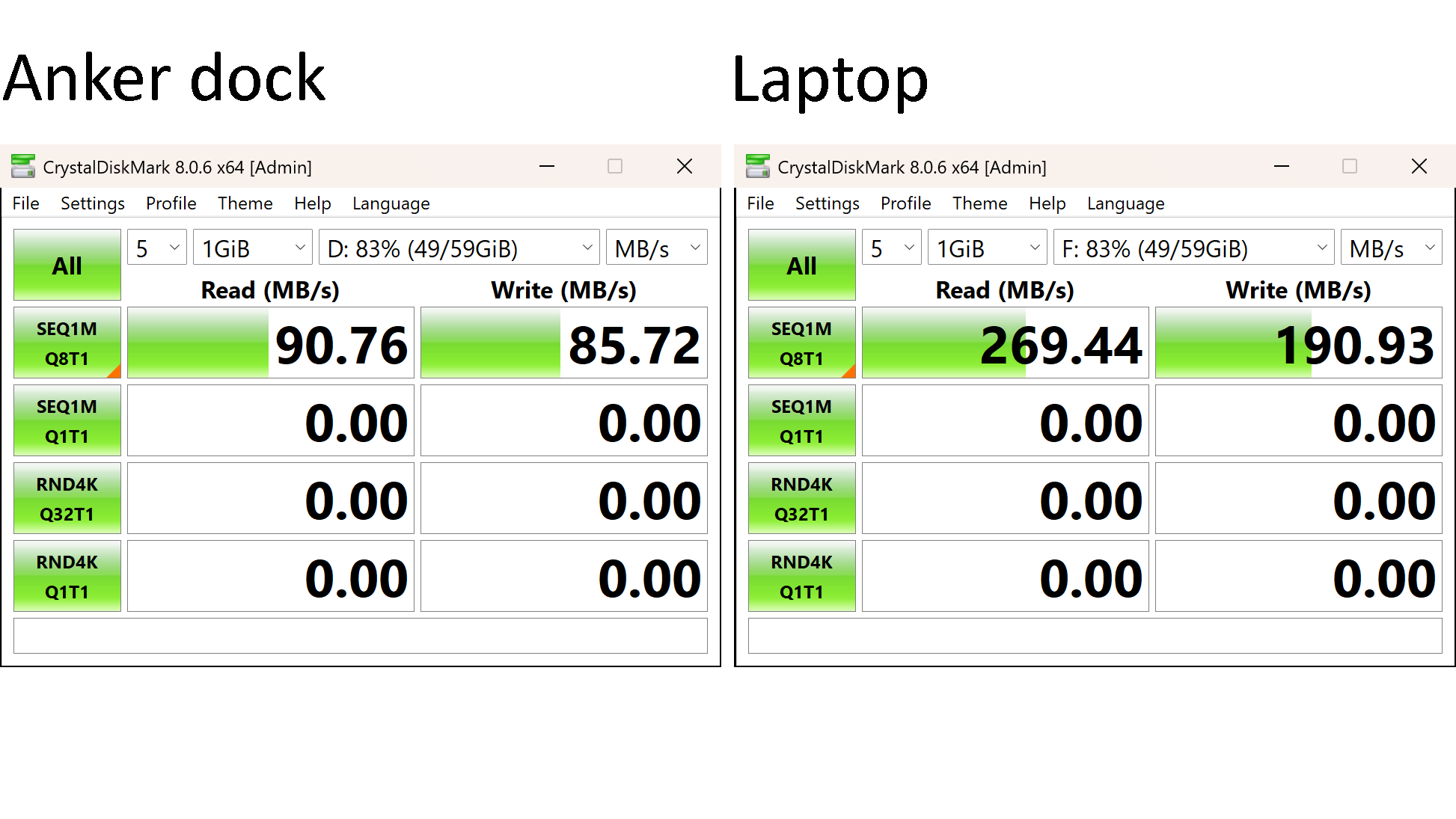
Testing the SD card slot on the side of the dock revealed it to have no negative impact on read or write speeds compared to plugging the same SD card into the laptop via a dedicated SD card reader. However, this was only true for UHS-I SD cards. Inserting a faster UHS-II memory card into the dock resulted in read and write speed of under 100MB/s, and this was the case for several different UHS-II SD cards that I tried. Plugging these same cards into my test laptop via a ProGrade Digital PGM0.5 UHS-II card reader resulted in transfer speeds far closer to the cards' advertised maximums, proving the dock's SD card slot to be the limiting factor here, not the laptop.
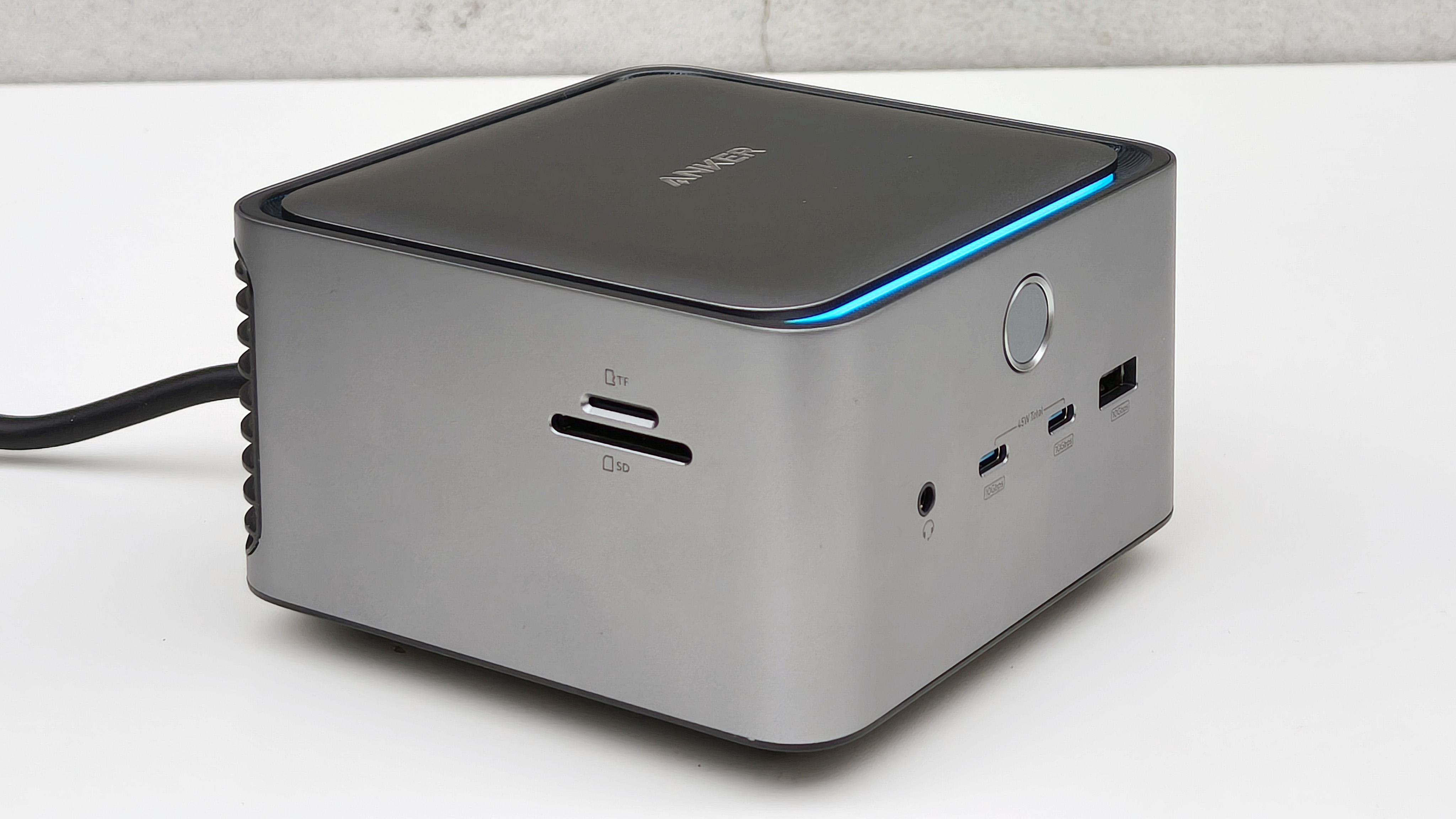
The remaining USB-C and -A ports each run at 10Gbps, so the dock has no problem maxing out these relatively slow connections. My laptop was also able to seamlessly output audio through the dock's 3.5mm headphone socket.
The dock's built-in Ethernet port performed faultlessly as well, slightly exceeding the download and upload speeds that the laptop could achieve over its Wi-Fi connection. However, my internet connection is ISP-limited to 150MB/s upstream and downstream, as that's all I pay for, so this test is really testing the limits of my wallet, not the dock's Ethernet connection!
Throughout my testing the dock remained cool and almost silent during operation.
Verdict
Quite simply, laptop docking stations don't get much better than the Anker Prime TB5 Multi-Function Docking Station. It offers the fastest possible dock performance available with current technology, along with excellent build quality and seamless ease of use. Even the very fastest storage devices I could muster were able to perform just as well when connected to the dock as they did when plugged directly into my test laptop. The only minor shortcoming is the dock's SD card slot, which doesn't seem to run at UHS-II speeds.
But, predictably, if you want to be at the cutting edge of tech, it's going to cost you. At the time of writing the Anker Prime dock costs $399, making it an expensive way to add ports to your laptop. Thunderbolt 4 docks can be had for less than half that, and unless you're particularly keen on staying future-proofed, one of those would be a more sensible buy.
But if you're fortunate enough to own a 2024 MacBook Pro with Thunderbolt 5, or an equally modern Thunderbolt 5 Windows laptop, the Anker Prime TB5 Multi-Function Docking Station will get the most out of your computer, providing you intend to connect very high-speed external storage devices, or multiple high-resolution monitors that require greater connection bandwidth than Thunderbolt 4 can offer.
Ben is the Imaging Labs manager, responsible for all the testing on Digital Camera World and across the entire photography portfolio at Future. Whether he's in the lab testing the sharpness of new lenses, the resolution of the latest image sensors, the zoom range of monster bridge cameras or even the latest camera phones, Ben is our go-to guy for technical insight. He's also the team's man-at-arms when it comes to camera bags, filters, memory cards, and all manner of camera accessories – his lab is a bit like the Batcave of photography! With years of experience trialling and testing kit, he's a human encyclopedia of benchmarks when it comes to recommending the best buys.
You must confirm your public display name before commenting
Please logout and then login again, you will then be prompted to enter your display name.
